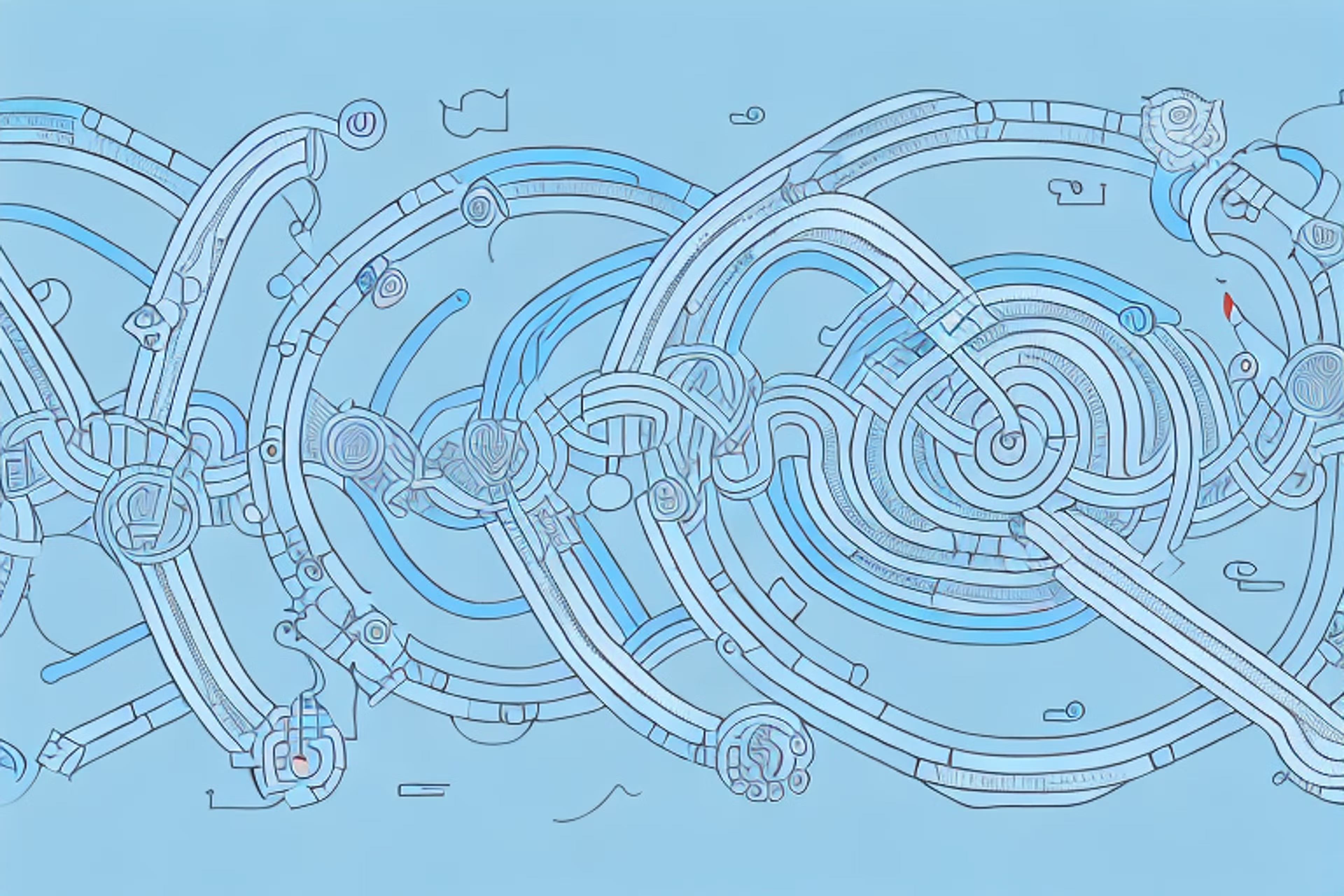Mapping User Journeys: A Guide for UX Designers and Product Managers
Discover the importance of mapping user journeys in UX design and product management with our comprehensive guide.
Posted April 10, 2025

Table of Contents
In today's digital age, user experience (UX) has become a critical component of product design, and mapping user journeys has emerged as a powerful tool for UX designers and product managers. In this comprehensive guide, we will explore the importance of user journeys in UX design, how to conduct effective user research, creating personas, identifying pain points and opportunities, designing touchpoints, measuring success, collaborating effectively, using tools and techniques, case studies, tips for iterating and evolving, common mistakes to avoid, and the future of user journey mapping. Whether you are new to UX design or an experienced professional, this guide will provide you with valuable insights and practical tips to help you enhance your user experience strategies.
Understanding the Importance of User Journeys in UX Design
User journeys refer to the paths that users take when interacting with a product or service. By mapping these journeys, UX designers can gain a comprehensive understanding of how users interact with a product, identify pain points and opportunities, and design solutions that enhance usability, functionality, and overall user satisfaction. User journey mapping is essential for creating products that meet the needs and expectations of users. By understanding the user's experience, UX designers and product managers can create products that are user-centric and customer-focused.
Moreover, user journey mapping can also help UX designers identify areas where users may drop off or abandon the product or service. This information can be used to optimize the user journey and improve conversion rates. Additionally, user journey mapping can provide insights into the user's emotional state and motivations, which can be used to create more engaging and personalized experiences. By understanding the user's journey, UX designers can create products that not only meet functional needs but also emotional needs, resulting in a more satisfying user experience.
The Benefits of Mapping User Journeys for Product Managers
Mapping user journeys provides numerous benefits for product managers. By analyzing user journeys, product managers can gain insights into how users perceive their products, identify areas of improvement, and design solutions that meet real customer needs. User journey mapping is also useful for identifying opportunities for innovation and differentiation. Product managers can use the information gained from user journey mapping to optimize the product roadmap, prioritize feature development, and make data-driven decisions.
Another benefit of mapping user journeys is that it helps product managers to understand the context in which users interact with their products. This includes understanding the user's goals, motivations, and pain points. By understanding the context, product managers can design products that are more intuitive and user-friendly, leading to increased user satisfaction and loyalty.
Furthermore, user journey mapping can help product managers to identify gaps in their product offerings. By analyzing the user journey, product managers can identify areas where users are dropping off or experiencing frustration. This can help product managers to identify new features or products that can fill these gaps and improve the overall user experience.
How to Conduct User Research for Effective Journey Mapping
User research is a critical component of journey mapping. It involves gathering data and insights about users, their needs, pain points, and goals. User research can be conducted using a variety of methods, including interviews, surveys, and usability tests. The key to effective user research is to ask the right questions and observe user behavior in a natural setting. User research is an ongoing process that should be integrated into the product development lifecycle.
Creating Personas to Enhance Your User Journey Maps
Personas are fictional representations of users that help UX designers and product managers better understand their customers. A persona should be based on real data from user research and represent a specific segment of the user population. Personas enable UX designers and product managers to empathize with users, create user-centric solutions, and tailor products to the needs and preferences of specific user groups. Personas should be updated regularly based on new user research and feedback.
Identifying Pain Points and Opportunities in User Journeys
Pain points refer to the problems and obstacles that users encounter when interacting with a product or service. Opportunities refer to areas where a product can be improved or expanded. By identifying pain points and opportunities in user journeys, UX designers and product managers can create solutions that meet real customer needs and provide a better user experience. Pain points can be identified through user research, customer feedback, and data analytics. Opportunities can be identified through market research, competitive analysis, and customer needs assessment.
Designing Touchpoints to Improve User Experience
Touchpoints refer to the points of interaction between users and a product or service. Touchpoints can be physical, digital, or emotional. By designing touchpoints that meet user needs and expectations, UX designers and product managers can create a seamless and intuitive user experience. Touchpoints should be designed with the user journey in mind and should be consistent with the brand and product vision. UX designers and product managers should also consider the accessibility and usability of touchpoints for all users, including those with disabilities.
Measuring Success with KPIs and Metrics for User Journeys
Measuring success is critical to the ongoing evolution of a product. This involves setting Key Performance Indicators (KPIs) and metrics that track user behavior, engagement, and satisfaction. KPIs and metrics should be aligned with business goals and customer needs. They should also be regularly monitored and analyzed to identify trends and opportunities for improvement. Common KPIs and metrics for user journeys include conversion rates, bounce rates, time on task, net promoter score, and customer satisfaction.
Best Practices for Collaborating on User Journey Mapping Projects
Collaboration is key to the success of user journey mapping projects. UX designers and product managers should work closely with stakeholders, developers, and other team members to ensure that user journeys are accurately represented and that solutions are aligned with business goals and customer needs. Best practices for collaborating on user journey mapping projects include using agile methodologies, breaking down silos, fostering communication, and leveraging collaboration tools.
Tools and Techniques for Creating Effective User Journey Maps
There are numerous tools and techniques available for creating effective user journey maps. These include user journey mapping software, flowcharts, diagrams, and visualizations. The key is to use the tool or technique that best represents the user journey and enables collaboration with stakeholders and team members. User journey maps should be regularly updated based on user research, feedback, and data analytics.
Case Studies: Successful UX Designers and Product Managers Share Their Journey Mapping Strategies
Case studies provide valuable insights into the strategies and techniques used by successful UX designers and product managers. By analyzing case studies, we can learn from the experiences of others and avoid common pitfalls. Successful UX designers and product managers prioritize user research, collaborate effectively with stakeholders, and use data-driven decision-making to optimize user journeys and create products that meet real customer needs.
Tips for Iterating and Evolving Your User Journey Maps Over Time
User journey mapping is an ongoing process that should evolve over time. UX designers and product managers should regularly update their user journey maps based on new user research, customer feedback, and data analytics. Tips for iterating and evolving your user journey maps include setting clear goals and objectives, involving stakeholders and team members, using feedback loops, and incorporating data analytics.
Common Mistakes to Avoid When Mapping User Journeys
Mapping user journeys can be a challenging process, and there are several common mistakes that UX designers and product managers should avoid. These include assuming user behavior, focusing too narrowly on touchpoints, failing to collaborate effectively, using generic personas, and neglecting to measure success. By avoiding these mistakes, UX designers and product managers can create user-centric solutions that meet real customer needs and provide a better user experience.
The Future of User Journey Mapping: Trends and Predictions
The world of UX design is constantly evolving, and user journey mapping is no exception. The future of user journey mapping is likely to be characterized by new technologies, such as virtual and augmented reality, as well as increased emphasis on accessibility and inclusivity. Other trends and predictions include the use of artificial intelligence and machine learning to analyze user behavior, the integration of user journeys with business intelligence and analytics, and increased focus on customer experience and engagement.
Conclusion: Key Takeaways for UX Designers and Product Managers Looking to Improve Their User Experience Strategies
Mapping user journeys is a critical component of creating user-centric products and services. By understanding the user's experience, UX designers and product managers can create solutions that meet real customer needs and provide a better user experience. Key takeaways from this guide include the importance of user research, creating personas, identifying pain points and opportunities, designing touchpoints, measuring success with KPIs and metrics, collaborating effectively, using tools and techniques, iterating and evolving over time, avoiding common mistakes, and staying abreast of trends and predictions. By following these best practices, UX designers and product managers can create products that delight their customers, achieve business goals, and drive growth and revenue.


















